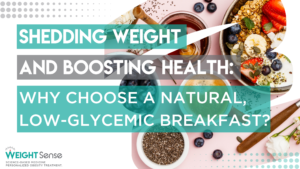Obesity stands as the primary risk factor for Type 2 diabetes mellitus.
See, Obesity is not just a weight issue—- or an aesthetic issue. It is a health risk, and it’s a well-established risk factor in the development of diabetes and cardiovascular disease.
A common denominator between obesity and diabetes is insulin resistance.
I think of insulin resistance as the “pre-” pre-diabetes.
Before there’s diabetes, there’s pre-diabetes, and before pre-diabetes, there are signs of insulin resistance.
See, Type 2 Diabetes is a progressive disease, and if we start to notice and treat the signs earlier before the disease sets in we can be successful in preventing the onset of Type 2 Diabetes and all of its known complications, such as heart attack, stroke, dementia, and kidney failure.
What is Insulin and Insulin Resistance?
Insulin resistance is when the body becomes less responsive to insulin.
Insulin is the hormone released by the pancreas and helps control blood glucose levels in the bloodstream. The body likes homeostasis and wants to maintain a blood glucose range between 60-100 fasting and less than 200 two to three hours after meals to stay healthy. Insulin is the hormone that tells the muscle, liver, and adipose cells to use the glucose available in the bloodstream after meals as an energy source.
But in insulin resistance, the body’s cells stop responding to the insulin signal. In essence, there’s so much glucose and insulin around in the bloodstream that the cells stop noticing the signals and stop responding.
Pre-Diabetes and Metabolic Syndrome
Over time, this leads to higher and higher blood glucose levels. The higher blood glucose levels are associated with other metabolic derangements, which can start to show on labs as signs of pre-diabetes and signs of metabolic syndrome—- this includes:
Increased Waist Circumference: >40 inches Men and > 35 inches Female
High Blood Pressure : ≥130/ ≥85 mmHg
Blood Glucose (Pre-Diabetes): ≥100 mg/dL
Increased Triglycerides: ≥150 mg/dL
HDL cholesterol: men <40 mg/dL (1.04 mmol/L) and women<50 mg/dL (1.30 mmol/L)
Clinically, this can start showing up for patients as signs of PCOS (irregular menstrual cycle, increased hair growth on the face, acne) or fatigue.
Type 2 Diabetes Diagnoses
Type 2 Diabetes is diagnosed when the labs show (2) of the following levels:
Random blood glucose greater than 200 mg/dL
Fasting greater than or equal to 126 mg/dL
Two-hour plasma glucose greater than 200 during a 75-g oral glucose tolerance test
HgA1c greater than or equal to 6.5
Eventually, the pancreas, whose beta cells produce insulin, may “burn out” or stop being able to produce the hormone insulin altogether. This is what happens in the later stages of Type 2 Diabetes when insulin is required.
When we have an excessive amount of large glucose molecules in our bloodstream at dangerously high levels, complications from Type 2 Diabetes can arise. These complications may include heart disease, dementia, kidney disease, retina (vision) disease, and nerve damage.
Preventing Type 2 Diabetes by Treating Obesity and Insulin Resistance:
As you can see, there is a progression of the disease before reaching Type 2 Diabetes.
Therefore, we can start intervening with lifestyle changes and pharmacology when insulin resistance and obesity are first noted. This can help address these conditions effectively.
How do we improve insulin resistance? The Lifestyle Bit.
- Increase protein, fiber, and healthy fat intake. This helps improve satiety and fullness.
- To optimize your health, reducing your consumption of processed carbohydrates, high fructose corn syrup, and sugars is advisable. These foods can trigger increased insulin secretion, elevated blood glucose levels, and insulin resistance. Additionally, they can lead to leptin resistance, which impairs the brain’s ability to feel full or satisfied. As a result, you may experience excessive hunger and intense cravings for food. Reducing your intake of these substances can better support your overall well-being.
- Aim to accumulate 150 minutes of moderate-level exercise each week to maintain an active lifestyle. This can be achieved by taking brisk walks for 30 minutes a day, five days a week. I suggest starting from your current level and gradually incorporating exercise into your daily routine. Although it may seem challenging at first, your future self will undoubtedly appreciate its positive impact on your overall well-being.
- Strength training enhances muscle insulin sensitivity and promotes glucose utilization from muscle storage. Additionally, it contributes to an overall sense of well-being. Remember, if you don’t use your muscles, you lose them!
- Optimizing sleep is paramount as inadequate rest or restlessness can result in heightened insulin resistance. Additionally, poor sleep boosts the hunger hormone ghrelin, which stimulates appetite and ultimately contributes to weight gain.
It sounds simple. But simple things are easy to do and easy not to do.
How do we improve insulin resistance? Pharmacology & Obesity Treatment
It’s important to note that losing around 7% of your total body weight can significantly reduce the risk of pre-diabetes progressing to diabetes. For instance, if you weigh 200 pounds, losing approximately 14 pounds can make a big difference. This level of weight loss can be achieved and sustained with comprehensive obesity treatment.
Some anti-diabetes medications can also reverse prediabetes and, therefore, prevent diabetes occurrence. This includes metformin and glucagon-like peptide-1 receptor agonists like semaglutide (brand Wegovy for Obesity Treatment and Ozempic for Diabetes Treatment).
Summary:
Obesity is the number one risk factor for Type 2 diabetes, as it is closely linked to insulin resistance. Insulin resistance occurs when the body becomes less responsive to insulin, leading to higher blood glucose levels. Pre-diabetes and metabolic syndrome are often precursors to Type 2 diabetes, characterized by increased waist circumference, high blood pressure, elevated blood glucose, and abnormal lipid levels. Lifestyle changes, such as improving diet, increasing physical activity, and optimizing sleep, can help improve insulin resistance. Additionally, weight loss of around 7% can significantly reduce the risk of pre-diabetes progressing to diabetes. Pharmacological interventions, including anti-diabetes medications and anti-obesity medications, can also be effective in preventing diabetes and improving health.
That’s why it is good to have a doctor on your team who understands obesity and type 2 diabetes, can meet you where you’re at, and can support you and care for you based on expert guidance and recommendations.
Book an appointment with me today. Together, we can transform your health dreams into an achievable reality.




